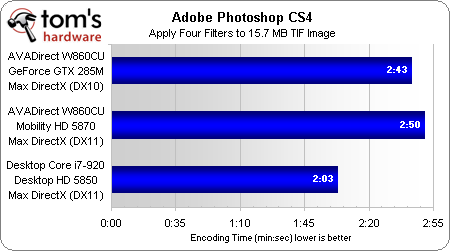AVADirect's W860CU: Mobility Radeon HD 5870 Vs. GeForce GTX 285M
Custom system builder AVADirect is one of the few companies to offer the flexibility of multiple graphics modules within the same notebook model. We used its high-end W860CU to compare AMD's and Nvidia's highest-performance mobile graphics processors.
Benchmark Results: Productivity
Adobe Photoshop surprises us with a noticeable difference between two notebooks that have the same CPU. The inability of Intel Turbo Boost in highly threaded applications hands a significant lead to the desktop processor’s higher non-boosted clock.
3ds Max 2010 shows the second notebook leading the first.
Recent versions of AVG don’t benchmark reliably.
WinRAR and 7-Zip are both highly threaded, with the use of four cores negating a benefit from Intel's Turbo Boost technology. We actually picked 7-Zip to replace WinZip because of its threading.
Get Tom's Hardware's best news and in-depth reviews, straight to your inbox.
Current page: Benchmark Results: Productivity
Prev Page Benchmark Results: Encoding Next Page Benchmark Results: Modern Warfare 2 And Crysis-
ta152h I'm a little confused why you'd choose an i7 920 to compare with a different platform, but maybe it's because I don't know the mobile platform that well.Reply
But, if it's like the P55, which it seems to be, there's the added uncertainty of the architecture thrown in.
Particularly with PCI-E being implemented differently, you might be seeing the inferior implementation of the P55 architecture responsible for a small amount of the relatively poor mobile performance. Since this implementation needs to multiplex the memory bus of the processor, you can run into situations where there is contention.
I doubt it's significant, but I'm curious why you wouldn't want to make a comparison with a more similar desktop platform. Was it because you couldn't get an unlocked Lynnfield to get the clock speeds for the processors the same in Turbo mode?
-
This doesn't make much sense to me... if a 5870M chip = roughly a 5770 desktop chip and a 285M = roughly an 8800gts.. why is it not completely spanking it? we all know 5770>8800.. by a rather large margin! what could be the cause of this?Reply
-
anamaniac Tom's, you should show your power usage results to AMD and ask for an explanation, on why a lower rated part is using more power.Reply
Granted, with a 45W CPU and 50W GPU, 30 mins is expected on a 40W battery if fully stressed. -
jkeopka I liked this article because I found it so darn relevant... I actually have this same Clevo Laptop, with the 5870 and 8 gigs of RAM.Reply
The GTX 285M was a $50 premium over the 5870, and I am glad I chose to stick to the 5870. It is kind of strange one would pay more to have less performance. I guess thats what fanboyism are all about? -
jkeopka anamaniacHow many partners use Clevo laptops and just rebrand them?Lots. Mine is a Sager 8690... which is a rebranded Clevo W860CU...Reply
I have seen this model at other sites as well. -
falchard Looks more like a bottleneck then anything conclusive. The results in nearly all the tests were close, yet 1 of them should have been clearly ahead.Reply
I think an ASUS JH73-A1 verse this would have been more interesting as its a bit cheaper for better parts. -
Crashman TA152HI'm a little confused why you'd choose an i7 920 to compare with a different platformSame speeds in Turbo mode, which is used during games, the primary focus being gaming performance.TA152HBut, if it's like the P55, which it seems to be, there's the added uncertainty of the architecture thrown in.That's true, but neither graphics solution provided the performance needed to highlight the mobile processor's on-die PCIe controller's performance advantage.TA152HI'm curious why you wouldn't want to make a comparison with a more similar desktop platform. Was it because you couldn't get an unlocked Lynnfield to get the clock speeds for the processors the same in Turbo mode? Exactly. Besides, Tom's Hardware has already seen that clock-for-clock, Lynfield games at least as well as Bloomfield when a single card is used. If nothing else, the comparison favors the mobile solution's lower power consumption.Reply




